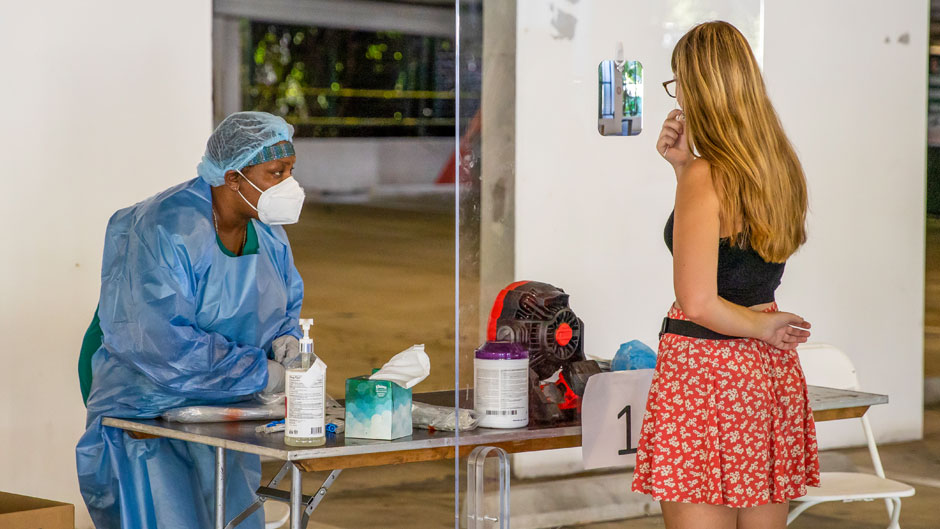When Florida’s first COVID-19 case was reported last March, the University of Miami had no way to test for the rapidly spreading novel coronavirus. Yet within three weeks a new laboratory cobbled together with instruments borrowed from researchers across the University began analyzing hundreds of samples every day for patients and health care workers.
Now, that ever-improving molecular pathology lab—which has performed more than 130,000 tests—has the capacity to process 3,000 COVID-19 tests a day. That monumental achievement is enabling the University to expand its mandatory student-testing initiative as the spring semester begins.
“It is a fantastic partnership between the research and clinical,” said Dr. Stephen D. Nimer, director of the Sylvester Comprehensive Cancer Center, who was charged with developing COVID testing and algorithms for patients and employees of the Miller School of Medicine and UHealth—the University of Miami Health System.
“When we began, we were in crisis mode,” Nimer continued. “We had an unfamiliar disease with no playbook, no established testing programs, no protocols. Yet we went from zero testing capacity to 500 tests a day in a few weeks. Now we can do 3,000 tests a day and know the answer in 30 minutes, four hours, 24 hours, or 48 hours—depending on the circumstances that the test is ordered.”
Dr. Merce Jorda, chair of the Department of Pathology and Laboratory Medicine, remembers the innumerable challenges of finding and validating instruments and acquiring reagents, swabs, and other in-demand supplies in a rapidly changing regulatory environment. She credits selfless and seamless teamwork for achieving the seemingly impossible.
“If you told me we’d be doing 3,000 COVID tests a day, I’d say, ‘You’re crazy. Of course not,’ ” said Jorda, also the director of UHealth Laboratories. “But as horrible as COVID has been, it had the wonderful secondary effect of melding different people with different skills, knowledge, and expertise into one team and behind one goal. Sometimes we joke we don’t know for whom we work. Whoever can help the most at that moment does it.”
Fortunately, at the onset of Florida’s outbreak last March, most University students were on spring break and did not return to campus until mid-August, when the fall semester began with a mix of remote and in-person classes. But reopening campus would not have been possible then without the student-testing initiative that, thanks to the growing capabilities of the rapidly expanded lab in the Miller School’s Mailman Center for Child Development, now includes more students, more frequent testing, and more testing sites. The pathology lab in the UHealth Tower is handling the bulk of COVID-19 testing for UHealth patients and front-line employees.
Beginning this semester, almost all students are required to undergo a mid-nasal swab COVID-19 test once a week at one of the three test sites now open for their convenience. In addition to the Pavia Garage, where last fall residential students were tested every 10 days and non-residential students every 12 days, test sites are now open on the Marine Campus without an appointment and to first- and second-year medical and graduate students on the Medical Campus with an appointment.
“Our plan for spring was to be even more inclusive and rigorous with the regularity of testing,” said Erin Kobetz, vice provost for research and scholarship, who is leading the University’s student-testing strategy. “So not only are we testing more students, but we’re testing them at a more frequent interval. Testing is and will remain our best defense against COVID because it provides the opportunity to identify asymptomatic infection, which is high among students, and halt widespread transmission.”
The only exceptions to the once-a-week requirement will be the roughly 1,500 students living in University Village or Lakeside Village. Soon, they’ll actually begin testing twice a week. But instead of swabbing their noses for a sample that will be sent off to the Mailman lab, they’ll take the quicker, easier, and cheaper breath test that first debuted on the Coral Gables campus last October—when the University became the first college to pilot the Israeli-produced COVID-19 Breath Analyzer. Users, who blow a few breaths into a small tube that is then placed into a COVID-19 scanner, can learn within minutes if they are positive.
Although the U.S. Food and Drug Administration has not completed its evaluation of the breath tester, Kobetz said the technology has proven effective in detecting the novel coronavirus. But, she emphasized, any student whose breath tests positive will immediately take a polymerase chain reaction (PCR) test, considered the gold standard for detecting the RNA specific to COVID-19.
And now, the Mailman Center COVID lab that, just 10 months ago, began operating with a single RNA extractor found at the Rosenstiel School of Marine and Atmospheric Science, is poised to process 3,000 PCR tests a day. This is thanks in part to new automation equipment and in-house modifications that, approved by the FDA, improved existing tests, making them more efficient and suitable for University use.
As Nimer explained, “Say the recipe says stir the butter and flour for 15 minutes. We’ve shown it works if you stir it only for 10 minutes.”
Yet, with new challenges ahead, there’s little time for celebration, or rest. Nimer, Jorda, and members of their ever-growing team are gearing up for the new and more contagious variants of the coronavirus. But, this time, they are not in crisis mode.
“Crisis mode has ended,” Jorda said. “We are now prepared, so we have Plan A, Plan B, Plan C, and Plan D.”

